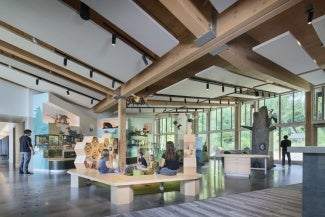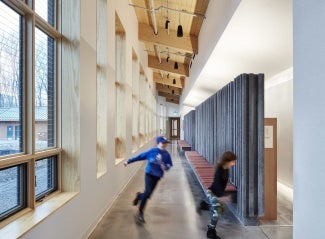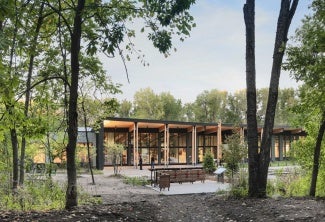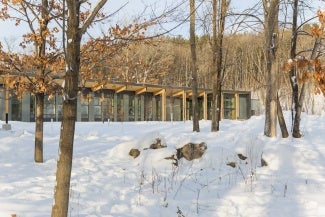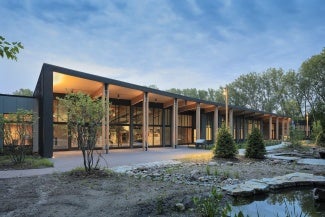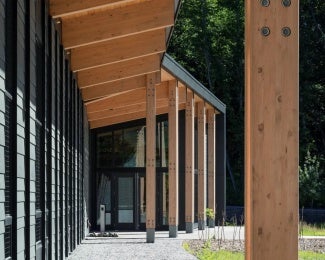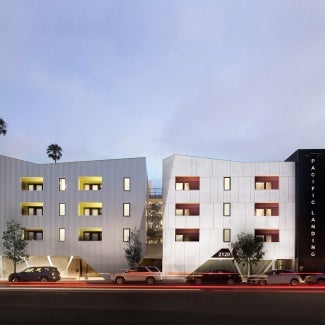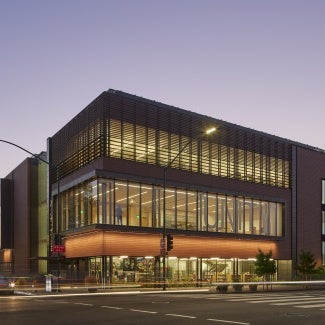Westwood Hills Nature Center
The award-winning sustainable design of the Westwood Hills Nature Center creates a community teaching tool for St. Louis Park, MN shaped by the city’s forward-thinking climate action plan that strives to achieve net zero by 2040.

Project highlights: Westwood Hills Nature Center
- Architecture Firm: HGA Architects and Engineers
- Owner: City of St. Louis Park
- Location: St. Louis Park, Minn.
- Project site: Previously developed land
- Building program type(s): Education – General, Public Assembly – Recreation
A new interpretive and accessible gateway to nature for the city of St. Louis Park, Minnesota, the Westwood Hills Nature Center immerses visitors in the surrounding forest full of birdsong and gentle breezes. Its design draws inspiration from the site with an exterior skin that evokes tree bark and a combination of fiber cement panels and window assemblies that subdivide and branch, much like the surrounding trees. The result of a vital partnership that included the design team, civic leaders, exhibit design specialists, and educators, the center is a true teaching tool and a vibrant amenity shaped by the city’s forward-thinking climate action plan that strives to achieve net zero by 2040.
AIA Framework for Design Excellence principles
The project aims to immerse the community in a natural preserve. The building acts as a lens into the forest while also serving as inspiration for how mindful awareness can help sustain this natural ecosystem. The building and systems design is an exemplar of holistic design and environmental conservation and used as a teaching tool for visitors.
The center’s exhibits and programming provide an interpretive gateway to the surrounding landscape, and the design takes its cues from the natural features of the site. The slender building allows views through it and ample opportunities to feel immersed in the forest when looking out from within. The experience of moving through the woods and marsh forms a conceptual framework for the design. The exterior skin of the building expresses bark-like layers of textures and colors. Fiber cement panels and wood window assemblies subdivide and branch, inspired by the geometry of the trunks, limbs, and leaf veins of trees and plants. The repeating but changing geometries of the façade allow for variation, responding to interior and exterior forces as the building stretches and bends east to west to optimize its orientation.
The exposed wood structure embodies the microscopic structure of bundled parallel cellulose fibers of wood at a larger scale. Glue-laminated members are built using smaller pieces, and columns are bundled in pairs along the exterior overhangs, forming entries and seating areas. The roof angles to the north and south, forming a central spine of building systems and better accommodating daylight and views from primary occupied spaces. It also captures rainwater for an interpretive water feature that showcases regional hydrology and evapotranspiration. While the building itself exhibits abstracted elements of the landscape, the primary experience for visitors is one of direct connection to nature. Occupants are immersed in views into the surrounding landscape, open windows let in the sounds of birdsong and wind through the trees, and the sun warms the corridor feature wall and bench for a comfortable place to sit.
The team that brought this project to life included architects, engineers, exhibit design fabricators, naturalists, educators, a city advisory committee, program/facilities/administration staff, a city planner and sustainability specialist, and the contractor. This entire team shared the goal of making the nature center a well-used community asset with the potential to change mindsets and the way projects are conceived and delivered for the city. This project was designed with a loose fit to allow day-to-day flexibility and long-term adaptability. A recently conducted post-occupancy evaluation underscored how much the teachers and staff who spend the most time on-site love this project.
The placement of the building is now far more convenient, the flexibility assures increased and diverse programming serves all members of the community, and the unexpected demand for evening rentals provides additional revenue for the city. Beloved buildings are the most sustainable, and we suspect this building will far outlast its predecessor.
The principal mission of the Westwood Hills Nature Center is to connect people to nature through its facilities and programming. The new site and building design create a more universally accessible and welcoming gateway to the landscape, encouraging people of all ages, backgrounds, and abilities to experience the place. Public spaces within foster informal gathering and provide fully accessible restrooms and comfortable, welcoming seating areas. The building design encourages wider community use in its formal and informal gathering spaces. The facility and exhibit design is meant to provide an easy, welcoming entry point to the landscape for all, including those in groups not as familiar or comfortable with the experience of the natural landscape of Minnesota. Google Translate interpretation has been included on exhibit signage to improve access to people who speak other languages.
The building also has restrooms available to all during daylight hours, even when the center is closed. Wayfinding signage includes braille. Lastly, the project leads by example with accessibility and inclusivity. It has spurred improvements to other facilities in the city.
Design intent
Who does the project serve? Identify the stakeholders who are directly or indirectly impacted by the project.
The building serves several communities within the city—the surrounding neighborhoods, the school district (with a special emphasis on elementary and middle school students), community groups (bird watchers, hikers/walkers, arts groups, local high school sustainability group, etc.), and the Twin Cities as a whole—as the nature center functions as both a local and regional destination.
Describe the stakeholder engagement process over the course of the project.
The master planning process that predated building design included community engagement through surveys and workshops. During the design process, numerous community engagement events solicited input, including pop-up engagement at community events, open house-style events at the nature center, and staff outreach at upwards of 70 neighborhood meetings to gather feedback and provide information on project status. Community input provided guidance on major features of the design, including accessibility and resource use.
Identify project goals that support equitable communities and describe how those goals were developed.
The accessibility and flexibility of the facility both promote the city-stipulated goal of connecting people of all ages, abilities, and socioeconomic status to nature through informal and formal use. The building provides accessible infrastructure to host a wide variety of uses, including school programs and camps, city meetings, community events, and informal daily use by community members. The interpretive programming forms part of the local school district’s STEM curriculum, and school programs touch the widest variety of community members from both an age and demographic standpoint.
Describe the project team's explorations or design strategies that respond to the above-stated goals.
Siting the building as a welcoming gateway to the nature preserve was critical for two reasons: to create a perception of belonging and security in the natural landscape among community members and to improve physical accessibility to increase use by people of all ages, backgrounds, and abilities. Program spaces provide maximum flexibility for use by all types of community groups, increasing access to the facility. A variety of restroom facilities provides all-gender options and flexibility for families. The exhibits and art installations reveal aspects of the surrounding landscape to help connect as wide an audience as possible to nature.
Describe stories or evidence that demonstrate how the project successfully contributes toward more equitable communities.
An increase in the number and diversity of visitors to the nature center is a key indicator of success. Expansion of programming for school-aged children, use of the facility for community events, and increased informal use of the nature center by hikers and birders have all occurred. The flexible design allowed staff to safely welcome visitors during the pandemic.
Every community is unique, and every project has unique has unique opportunities to respond to issues of equity and inclusion. Describe any exemplary practices or outcomes for this project.
A critical outcome of the project is the closer, barrier-free visitor experience to the building, forest, and trails beyond, which the former facility was unable to provide equitably. The location and configuration of the building and drop-off access solved one of the biggest problems of the original facility by bringing the building close to the parking area. This eases access, creating a facility welcoming to all ages and abilities. Through a single-story program with convenient, barrier-free site accessibility, staff who are disabled can work in the building, both in the front of house and behind the scenes. The flexibility of the multipurpose rooms allowed staff to modulate visitor capacities and flows, making it safer and more welcoming to all guests before COVID-19 vaccines were available. Because safe distancing was accomplished, this became one of the few indoor visitor facilities nationwide to remain open from the center’s premiere in the summer of 2020 through the end of that year. A comprehensive resiliency analysis was conducted early in the project to identify potential threats. The biggest future threat was increased precipitation extremes. This led to a modified foundation design and expanded emergency power so the center can become a community shelter during emergencies.
The restored landscape of the nature center includes examples of all of Minnesota’s regional biomes. The lake and marshland represent its largest feature. Stormwater management, critical to the evolution and history of the site, forms the conceptual foundation for the site design. The management system includes a relocated bog, clarified existing pond, and infiltration basins with native plantings that treat stormwater while providing habitat for local species. An interpretive feature uses stored rainwater captured by the building’s roof to demonstrate site hydrology. The building resides in a lively bird habitat and has a fair amount of glazing to create a strong visual connection to the surrounding site. To reduce bird strikes, plantings were pulled away from the building, and the project uses two types of bird-friendly glass, a UV-reflective coating, and a ceramic frit pattern. Bird strike research is a quickly developing field, so the team attended an Audubon Society-sponsored lecture by bird safety researcher and ornithologist Daniel Klem and worked directly with Pella Windows to source both glass types for the project.
See Fig. 1 Design for Ecosystems.
Design intent
How does the design minimize negative impacts on animals?
Because the project sits within bird habitat and in migratory paths, dark sky and bird-friendly strategies were integrated into the design. Site lighting with cutoffs minimizes impact on migrating birds and reduces light pollution, and bird-friendly glazing throughout the building utilizing UV-reflective coats and ceramic frit patterning to reduce bird strikes while maximizing views and daylighting in the building.
How does the project support biodiversity and improve ecosystem services?
The design promotes biodiversity and habitat conservation through use of native plant species, which increase habitat for pollinators as well as other insects, birds, and animals. Site stormwater management features, such as a bog and infiltration basins, all contribute to maximizing on-site habitat.
Metrics
56.5% of site area was vegetated (landscape or green roof) pre-development.
38.5% of the site area is vegetated (landscape or green roof) post-development.
There was a 0% increase in percent of vegetated area, post-development.
95.8% of the vegetated areas are planted with native species.
The building and site design present an interpretive example of best stormwater management practices. The building, sited near the marshy wetland of Westwood Lake, captures roof and site rainwater runoff and treats it to minimize the impact on the watershed. The rainwater runoff captured from the roof feeds an underground storage pipe, from which rainwater is pumped via both solar- and hand-powered pumps through a series of filtration basins to form an interpretive feature demonstrating the area hydrology. Further filtration basins with native plantings treat runoff by reducing the discharge of sediment and phosphorus off-site. Pervious paving areas in the parking lot also filter stormwater runoff. Interpretive signage throughout the site explains the strategies for managing stormwater to visitors. Stormwater management features exceed the Bassett Creek Watershed District requirements.
The design team worked with the center’s staff to understand ways to minimize potable water usage associated with the care of the raptors and exhibit terrariums, as well as the annual cleaning and maintenance of the rooftop solar systems. In addition, the building's mechanical systems are closed-loop ground-source heating and cooling systems that require no municipal water use.
Design intent
Describe how the project's stormwater and potable water strategies contribute to site and community resilience.
The project helped reduce the reliance on municipal water sources by using native landscaping to eliminate the need for a permanent irrigation system and by reducing indoor water use by 38% through low-flow fixtures. Stormwater management features prominently in the design of the project due to its proximity to the lake and surrounding marsh. Stormwater management practices were all designed to factor in the expanded storage capacities necessary for predicted future extreme precipitation events.
Describe the quality of the water that runs off the site.
Stormwater is treated through filtration to remove 60% of the annual total phosphorus and 72% of the annual total suspended solids from the site discharge.
Describe how and where the project's black water is treated.
Black water is treated at city’s municipal wastewater treatment facility.
Metrics
Water use intensity (gal/sf/year)
Benchmark: 12.1
Predicted: 10
Measured: 10.2
Reduction in potable water use (from benchmark)
Predicted: 17.5%
Measured: 15.8%
Total annual water demand met using potable sources
Predicted: 100%
Measured: 100%
81.6% of stormwater is managed on-site.
Multipurpose spaces form the heart of the building, and the owner could adjust class sizes as needed (for example, increasing class space for COVID-related social distancing for summer camps) and offer after-hours use for the city, community groups, and the public. Staff spaces can be adjusted based on the seasonally projected ebb and flow of staff. Design of flexible spaces enabled the reduction of a classroom to right-size the building and provide the most value for the city. Exhibit and program spaces provide interpretive programming as well as after-hours event and gathering spaces for rental income. Lowered operational costs due to reduced utility costs and rental income bolster operational budgets to support facility operations and free up funds to make improvements and expand offerings on the 160-acre site.
To balance first cost with long-term value, the team analyzed multiple mechanical schemes against first cost and life cycle cost for “typical” code minimum systems. Energy efficiency measures were driven by life cycle cost analysis, which showed paybacks near 15 years for the project without utility rebates or future social costs of carbon.
Design intent
How does this project contribute to local and/or disadvantaged economies?
The demand for the evening event rentals is higher than expected, resulting in a greater than anticipated revenue stream for this project. This added income contributes to the economic health of the center and the city. This demand is due in part to the center’s design and the unique project setting, which was not previously available to this community.
How did design choices reduce system sizes and minimize materials usage, allowing for lower cost and more efficiently designed systems/structure?
Energy modeling enabled the team to optimize the thermal envelope and building loads for performance and economy. Through modeling, it was determined that assumptions about super-insulating the roof and using triple-element glazing were not the most economical means to achieve the zero energy goal. In the final design, roof insulation was reduced from R60 to R45, and windows were dual glazed. The wood structure was designed to be exposed and integrated into the architectural design to minimize unnecessary ceilings and finishes. Spans are optimized and roofs cantilever where possible to eliminate additional columns and foundation work.
How did lifecycle cost analysis influence the project's design?
A life cycle cost analysis (LCCA) was critical to optimizing design strategies for the project. While geothermal VRF systems showed the lowest energy use for the project, first costs and estimated simple maintenance for geothermal heat pump systems showed an improved life cycle performance, with a discounted payback of 19.6 years for the geothermal heat pump system—less time than a four-pipe fan coil system. After the envelope and systems were finalized, the LCCA demonstrated that the design would save $320,000 in today’s dollars over an equivalent non-net zero building.
Cost
Construction cost per sq. ft.: $759.31
The building has achieved Zero Energy Certification from the International Living Future Institute (ILFI). To determine the budget, the team benchmarked and established an EUI target early with assumed additional first cost impacts of systems for a zero energy building. An “energy budget” was established and monitored throughout the design. An initial energy-sensitivity analysis established what “low-hanging fruit” was available in terms of both passive and active strategies appropriate to the local site and climate. The envelope, orientation, and shading were optimized for efficiency to take advantage of existing site resources—sun and wind—and maximize use of passive heating, cooling, and daylighting. Thermal mass for winter solar gain and in-floor radiant heating achieve comfort during cold weather, and “task-oriented” ventilation strategies with operable windows and ceiling fans are low-energy ways to achieve comfort in warmer months. The system setpoints were optimized to maximize efficiency, and energy loads were reduced using LED lighting and a geothermal well field to supplement the all-electric boilers as a heat source for the radiant floor. Use of WeatherShift to project future weather data, as well as historic data, in the energy model ensured future performance would meet the zero energy goal.
Explore the Westwood Hills Nature Center’s passive strategies in Fig. 2 Design for Energy.
Design intent
Describe any energy challenges associated with the building type, intensity of use, or hours of operation, and how the design responds to these challenges.
The most underestimated energy challenge associated with this building type is the additional use for after-hours rentals, which can be hard to predict. The team established an “energy budget” for the project with this additional night-time use factored in. The design maximizes passive strategies to offset the additional after-hours use and has achieved its zero energy target despite the popularity of the space for rentals.
Most importantly, this inspiring building clearly demonstrates how thoughtful design can impact the environment and human well-being. The building tells a story that brings more awareness to an entire community.
Metrics
Is the building all-electric? Yes.
In its measured usage, including on-site renewables, did the project achieve its 2030 Commitment reduction target (70% reduction by 2015, 80% reduction by 2020)? Yes.
The project's total carbon (embodied + operational) over 10 years in kg CO2e is 198,789.9.
There is a 100% reduction (inclusive of renewables) from benchmark, measured.
100% of total energy is derived from renewable sources, measured.
There is a 100% reduction (inclusive of renewables) in operational carbon from benchmark, measured.
Critical to the occupants' well-being is connection to the outdoors. Offering views out, and through the building, to the preserve for a full nature immersion was a key objective. Daylight is maximized throughout, and large operable windows provide thermal comfort without additional energy use. Photosensors, dimmable LED fixtures, and the strategic use of reflective soffits along the classroom corridor work together to provide evenly daylit spaces. The species selection for the wood structure and roof deck impacts indoor air quality. Most species options would have required chemical pressure treatment, while the Alaskan yellow cedar that was selected requires no treatment or varnish, preventing off-gassing of toxic chemicals. The prominent finishes on the project—flooring, paint, ceilings—were selected based on their environmental and human health attributes and evidence of product transparency and third-party certifications. Decorative finishes were minimized; the building’s structure is largely exposed and the floor is polished concrete. This approach minimized excess materials and reduced VOC off-gassing of adhesives, coatings, etc. The colors, patterns, and forms of the interior are meant to spark joy, and their biophilic alignment with the flora and fauna found in Minnesota’s landscape resonates with our inherent attraction to nature.
See Fig. 3 Design for Well-being.
Design intent
Was a chemicals of concern list or other third-party framework used to inform material selection? If so, how?
Declare, Cradle-to-Cradle, and Living Product Challenge Red List were frameworks used to select materials for the project. Chemicals of concern that were avoided include phthalates, formaldehyde (added), asbestos compounds, and wood treatments containing creosote or pentachlorophenol. The additional materials and accessories (window treatment, fabric, laminates, wall base) all feature at least one third-party certification for environmental and/or health benefits or provide product transparency of an EPD/HPD.
How did the project advocate for greater transparency in building material supply chains?
FSC certification for all wood products was specified, and third-party certifications were required for major interior finishes—ceilings, flooring, and paint.
Metrics
90% of the regularly occupied area is daylit (sDA 300/50%).
90% of the regularly occupied area is compliant with annual glare criteria (ASE 1000, 250).
90% of the regularly occupied area has quality views.
64% of the regularly occupied area has access to operable windows.
1,100 is the design goal for maximum CO2 in parts per million (ppm) when spaces are fully occupied. The goal is relative to an absolute value.
Efficient use of resources and durability were key drivers for systems and material selection for the building. Its elemental architectural palette of wood structure and polished structural slab allow the building’s exposed components to be used as a teaching tool. Windows and glue-laminated wood structural elements were fabricated regionally, reducing transportation impacts. The bolted connections of the structure allow for its disassembly. While the existing building needed to be removed as part of the project, it was deconstructed so that as much of its various components, such as glue-laminated wood beams, windows, and the roof deck, could be reclaimed and reused.
In addition, the exhibits were intentionally planned to be low tech in their heating and lighting to support the center’s energy use target. This approach provides exhibits that do not compete with nature but serve to interpret it most appropriately and in keeping with the general, modest aesthetic of the building.
See Fig. 4 Design for Resources.
Design intent
Did embodied carbon considerations inform the design? How?
The use of wood for structural and nonstructural components, exterior cladding, and finishes was deliberate for both its experiential warmth and its lower-carbon footprint compared to other material options.
Did the idea of circularity/circular economy inform the design? How?
The building was detailed for deconstruction. It might have a 50- to 75-year life, and the main structural components will likely outlast the building itself. Bolted connections will allow for future disassembly. Moreover, the many material choices with high recycled content already confirm a commitment to extending the life of raw materials. The adaptability and flexibility of the design alone will ensure a far longer life than the previous building.
Describe any special steps taken during design/construction to make disassembly, deconstruction, or reuse easier at the building's end of life.
The old building site provides an outdoor program and event space. The building was deconstructed, and its reclaimed timber beams remain as benches around the new facility.
Metrics
0% of project floor area was reused or adapted from existing buildings.
Was embodied carbon modeled? Yes.
17.3 kgCO2e/sf is the project's embodied carbon intensity.
Some of the installed wood is FSC certified.
The center’s function is anticipated to remain consistent, but the design of the multipurpose classrooms and support spaces allow the building to flex, accommodating a variety of non-programmed uses. A resilience workshop was held to assess potential risks to the project—everything from public safety threats to climate change impacts. The city was particularly concerned about the longevity of the zero energy design. Future weather data played a key role in verifying the performance of building systems well into the future. The team used multiple WeatherShift data sets in its energy model to compare performance using different projected climate and global warming scenarios—from best case to worst case—ensuring optimal system performance and net zero energy use over the building’s lifespan. Minnesota’s cold climate is projected to warm, with increased precipitation events, so heating loads will reduce, and cooling loads will increase; data indicates a predicted decrease in overall energy use because the building’s energy use is heating dominated. Therefore, the zero energy goal remains achievable over the building’s life span, even as the region’s climate evolves.
A post-occupancy evaluation was conducted, and respondents claim the building’s spaces are flexible enough to accommodate current and future needs.
“This project is both beautiful and tells a story that bridges the past and the future.”—Jury comment
Design intent
In what ways does the design anticipate climate change over the life of the building?
Predicted changes in weather patterns, such as warming temperatures as well as increases in large precipitation events (rain and snow), are factored into the design of HVAC systems and stormwater management features of the site and building. Using future weather data sets (WeatherShift), our team tested various predictive scenarios to establish that the design would hold up to a range of potential climate futures in terms of both energy and stormwater management.
How does the design anticipate restoring or adapting function in the face of stress or shock, such as natural disasters, blackouts, etc.?
The building’s multipurpose program spaces, which have catering support space, can be used to support the community in a crisis. It provides a large space that can be used for gathering or sleeping in a crisis situation, and an emergency generator can provide continuous power. This was put to the test when the center opened in 2020. Safer distancing and proper visitor flow was accomplished using the multipurpose rooms.
Metrics
Research Score: 60
Resiliency Score: 50
Through passive sustainability, the building can function for 72 hours. The building includes a full backup power generator with diesel fuel tank to remain operational for 72 hours. The diesel-powered emergency generator is independent of the city natural gas service to help diversify emergency services throughout the city (the city also has natural gas-powered generators at different facilities).
The “building as a teaching tool” concept that drove the design of Westwood Hills Nature Center brought many lessons to a wide audience. The client has been enthusiastic about co-presenting these stories with the design team at several conferences. Building and site tours led by naturalists and design team members have featured the design. In particular, parks professionals are an audience for the project. At the 2019 Minnesota Recreation and Parks Association (MRPA) annual conference, the team presented the project as a case study for early planning by parks and recreation professionals (“Feasibility 101”). The project was a featured tour at the 2021 MRPA Conference, and the city was awarded an Innovation in Park Design Award from the National Recreation and Parks Association. The project was presented by an owner/design team panel at USGBC’s IMPACT 2019 x GSCE (Green Schools Conference & Expo) Conference in Saint Paul, Minnesota, highlighting both project goals and response to future climate projections (“Considering Future Climate: Will Net Zero Remain Net Zero?”). The team presented at the Net Zero 2020 virtual conference, reaching a nationwide audience. Internally, this project has been a case study for holistic design, resiliency planning, and using future climate data.
Design intent
What lessons learned through this project have been used to improve subsequent projects?
Two lessons serve as actionable takeaways for subsequent projects: combining architectural and engineering concepts early in design to set performance goals and ensure a high-performance facility with an integrated design, and the importance of tight specifications and construction observation to achieve a high-performance, tight building envelope.
If a post-occupancy evaluation was conducted, describe the process and outcomes.
A post-occupancy evaluation was conducted in November 2022, consisting of an online questionnaire and in-person focus group with employees, volunteers, and teachers. An in-person, 90-minute focus group was conducted with members of the nature center staff and included topics similar to those in the questionnaire. Findings were positive, including respondents' claim that the flexibility of the building spaces accommodates current and projected future needs. Moreover, the energy conservation of the building not only reduces resources needed to support building operation but also provides an educational opportunity for visitors. A curriculum was created about the building’s energy conservation.
If a post-occupancy performance testing was conducted, describe the process and outcomes.
Thermal imaging was used to identify air infiltration, leading to subsequent remedial work to repair holes in the air barrier at sprinkler pipe penetrations.
Metrics
Post-Occupancy Evaluation Score: 70
Transparency Score: 80
Commissioning Score: 40
Feedback Score: 80
Project team & Jury
Year of design completion: 2018
Year of substantial project completion: 2020
Gross conditioned floor area: 13,565 sq. ft.
Number of stories the building has: one
Project site: previously developed land
Project site context/setting: suburban
Annual hours of operation: 2,700
Site area: 167,088 sq. ft.
Cost of construction, excluding furnishing: $10,300,000
Total annual users: 35,989
Architect: HGA
Construction Manager: RJM Construction
Exhibit Design: Split Rock Studios
Site/Environmental Water Feature Consultant: Barr Engineering
Engineer - Civil: HGA
Engineer - Structural: HGA
Engineer - MEP: HGA
Interior Design: HGA
Landscape Architect: HGA
Lighting Design: HGA
Sustainability Consultant: Integral Group
Katie Ackerly, AIA, Chair, David Baker, Oakland, Calif.
Julian Owens, Assoc. AIA, Jacobs, Arlington, Va.
Seonhee Kim, AIA, Design Collective, Baltimore
Avinash Rajagopal, Metropolis, New York
The COTE® Top Ten Award is the industry’s best-known award program for sustainable design excellence.
Explore ten projects setting the standard in design and sustainability, presented by the Committee on the Environment.

